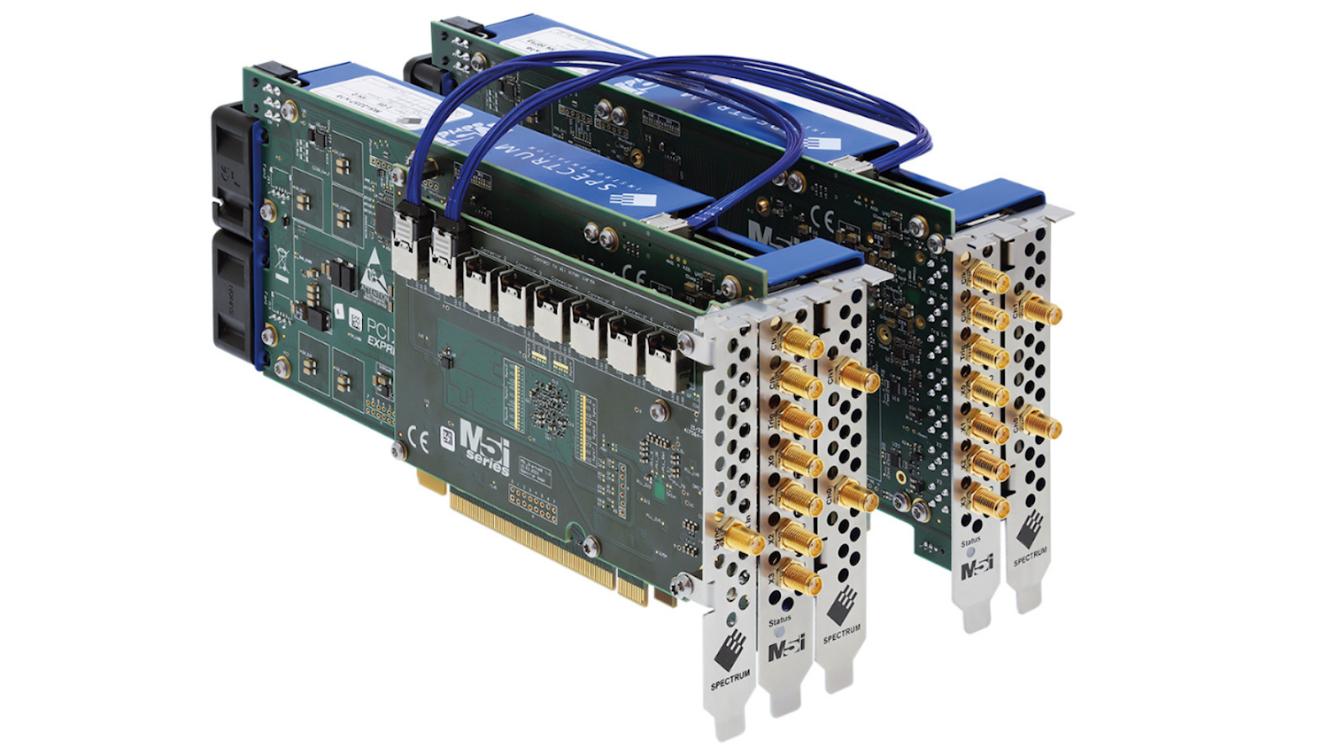Called Star-Hub, the option allows up to 8 of the company’s flagship PCIe digitisers (M5i.33xx series) to be connected together. Individual cards then share common clock and trigger signals, which ensures there is minimal phase delay and timing skew between all the channels. The Star-Hub option is installed by mounting a single piggyback module onto any of the M5i series cards in the multi-channel system. Using accurately matched and shielded coax cabling, the board then distributes the clock to each module and precisely synchronises the trigger event with the system clock.
Star-Hub can be used with any of the cards from the M5i.33xx digitiser family. Seven different models are available offering one or two channels, sampling rates from 3.2 to 10 GS/s, 12-bit vertical resolution and bandwidths from 1 to 4.7 GHz. The cards can handle a wide range of signals and feature programmable input voltage ranges, offset control, large on-board memories, advanced trigger functions and a number of different acquisition modes. Together with Star-Hub, the line-up lets you build data acquisition systems with from 2 to 16 channels, sampling at rates of up to 5 GS/s, or up to 8 channels at the maximum sampling rate of 10 GS/s.
Users can also choose to run the Star-Hub system with the digitiser cards internal clock, which offers better than ±1 ppm accuracy, or an external clock, via a front panel SMA input connector. To minimise any channel-to-channel timing skew, there is a programmable skew adjustment available for each connected card. This feature allows time shifts up to 200 ps (10 GS/s) or 312 ps (3.2 and 6.4 GS/s) of the clock of each individual card. It thus creates an easy way for users to correct any timing mismatches that may be present in their specific setup.
The ability to create customised multi-channel data acquisition systems, that can synchronously acquire signals in the GHz range, is ideal for a wide variety of applications. For example, they can provide a unique measurement solution in fields like communications, automated testing, aerospace and scientific experimentation, where banks of receivers, detectors, sensors or antennas are deployed.
Fast data transfer for processing and storage
Another advantage of the Star-Hub system is that each card retains its own 16 lane, Gen3, PCIe bus, that is capable of transferring data at rates up to 12.8 GB/s. This transfer speed allows continuous transfer at 6.4 GS/s in 12-bit mode, or even 10 GS/s in data-saving 8-bit mode. The bus allows the cards to shift acquired data to PC resources like memory, SSDs and GPUs at exceptionally fast speeds, even though they are all controlled by a single host processor.
Multi-channel control and display
Specifically designed for multi-channel systems, the company also has its own measurement software called SBench 6 Professional. This interactive GUI can control all the cards connected with Star-Hub. It runs on PCs, using either Windows or LINUX operating systems, and provides complete instrument control, along with display, analysis, storage, and documentation capabilities. SBench 6 can handle large data files and has several processing tools, including a plug-in interface that allows the use of custom calculation functions. There are also cursor and parameter functions that enable cross-channel measurements, as well as variety of import and export filters.
Software Development Kit
Every M5i digitiser is also shipped with a software development kit (SDK) as standard. The SDK allows them to be programmed with almost any common language. This includes C, C++, Python, C#, Delphi, VB.NET, J#, Julia, Java, LabVIEW, and MATLAB. The SDK contains an assortment of programming examples and all the driver libraries necessary for running under a Windows or LINUX operating system.
For more information email Vepac Electronics or call 011 454 8053














